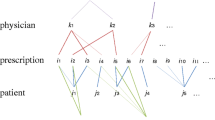Abstract
The importance of prices, doctor and patient characteristics, and market institutions for the likelihood of choosing generic drugs instead of the more expensive original brand-name version are examined. Using an extensive dataset extracted from The Norwegian Prescription Database containing all prescriptions dispensed to individuals in February 2004 and 2006 on 23 different drugs (chemical substances) in Norway, we find strong evidence for the importance of both doctor and patient characteristics for the choice probabilities. The price difference between brand and generic versions and insurance coverage both affect generic substitution. Moreover, controlling for the retail chain affiliation of the dispensing pharmacy, we find that pharmacies play an important role in promoting generic substitution. In markets with more recent entry of generic drugs, brand-name loyalty proves to be much stronger, giving less explanatory power to our demand model.

Similar content being viewed by others
Notes
Another doctoral procedure would be the “two-line method”. Here the doctor signs either on a line that reads “brand-name necessary” or on a line that reads “substitutions allowed”. Both methods have been in use in the US, and proved to have an impact on the number of refusals. The two-line method generates more refusals than the active substitution method [12].
The stepped price model was actually proposed by the pharmacy chains.
References
Aronsson, T., Bergman, M., Rudholm, N.: The impact of generic drug competition on brand-name market shares—evidence from micro data. Rev. Ind. Organ. 19(4), 423–433 (2001)
Berndt, E.R.: Pharmaceuticals in US Health Care: determinants of quantity and price. J. Econ. Perspect. 16, 45–66 (2002)
Brekke, K.R., Grasdal, A.L., Holmås, T.H.: Regulation and pricing of pharmaceuticals: reference pricing or price cap regulation? Eur. Econ. Rev. 53, 170–185 (2008)
Caves, R.E., Whinston, M.D., Hurwitz, M.A: Patent expiry, entry and competition in the US pharmaceutical industry. Brookings papers on economic activity. Microeconomics, pp. 1–48 (1991)
Coscelli, A.: The importance of doctors’ and patients’ preferences in the prescription decision. J. Ind. Econ. 3, 349–369 (2000)
Dalen, D.M., Strøm, S.: The pharmaceutical market in Norway. In: Sørgard, L. (ed.) Competition and welfare—the Norwegian experience, pp. 51–70. The Norwegian Competition Authority, Norway (2006)
Dalen, D.M., Strøm, S., Haabeth, T.: Price regulations and generic competition in the pharmaceutical market. Eur. J. Health Econ. 3, 208–214 (2006)
Frank, R.G., Salkever, D.S.: Generic entry and the pricing of pharmaceuticals. J. Econ. Manag. Strategy 6, 75–90 (1997)
Furu, K.: Drug utilisation in a public health perspective: establishing a national prescription register in Norway. Norw. J. Epidemiol. 11(1), 55–60 (2001)
Furu, K.: Establishment of the nationwide Norwegian Prescription Database (NorPD)—new opportunities for research in pharmacoepidemiology in Norway. Norw. J. Epidemiol. 18(2), 129–136 (2008)
Grabowski, H., Vernon, J.: Brand loyalty; entry, and price competition in pharmaceuticals after the 1984 drug act. J. Law Econ. 35, 331–350 (1992)
Hellerstein, J.: The importance of physician in the generic versus-trade name prescription decision. RAND J. Econ. 29, 109–136 (1998)
Lundin, D.: Moral hazard in physician prescription behaviour. J. Health Econ. 19(5), 639–662 (2000)
Norwegian Association of Pharmaceutical Manufacturers: Facts and figures. Norwegian Association of Pharmaceutical Manufacturers, Oslo, Norway (2008)
Pavcnik, N.: Do pharmaceutical prices respond to potential patient out-of-pocket expenses? RAND J. Econ. 33(3), 469–487 (2002)
Regan, T.L.: Generic entry, price competition, and market segmentation in the prescription drug market. Int. J. Ind. Org. 26(4), 930–948 (2008)
Scherer, F.M.: Pricing, profits, and technological progress in the pharmaceutical industry. J. Econ. Perspect. 7, 97–115 (1993)
Scott Morton, F.M.: Barriers to entry, brand advertising, and generic entry in the US pharmaceutical industry. Int. J. Ind. Org. 18, 1085–1104 (2000)
Train, K.: Discrete choice methods with simulation. Cambridge University Press, Cambridge (2003)
Acknowledgments
We thank Vivian Dyb for excellent research assistance, and participants at the annual National Health Economics Conference 2007 for helpful comments. We wish to acknowledge the services of the Norwegian Prescription Database in providing data. This research is supported by grants from the Norwegian Research Council. We thank two referees for constructive criticism and very helpful comments.
Author information
Authors and Affiliations
Corresponding author
Rights and permissions
About this article
Cite this article
Dalen, D.M., Furu, K., Locatelli, M. et al. Generic substitution: micro evidence from register data in Norway. Eur J Health Econ 12, 49–59 (2011). https://doi.org/10.1007/s10198-010-0226-6
Received:
Accepted:
Published:
Issue Date:
DOI: https://doi.org/10.1007/s10198-010-0226-6




